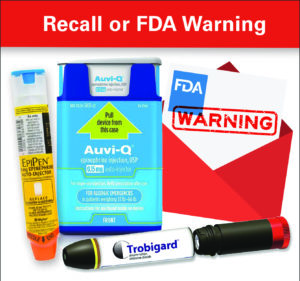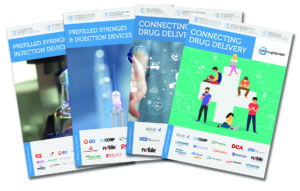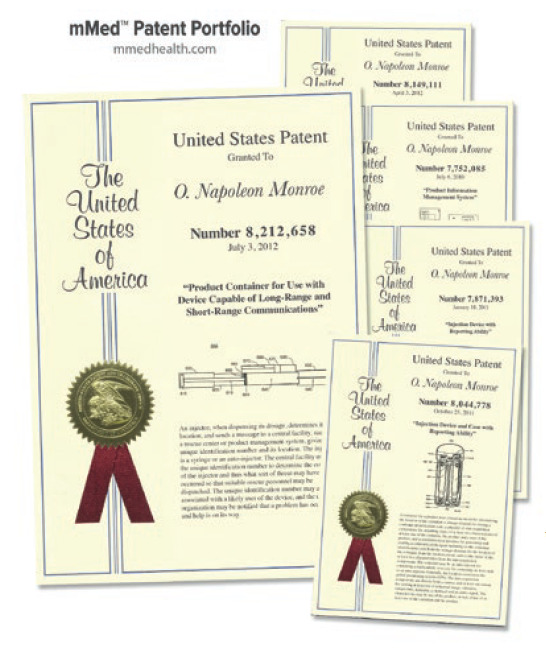Citation: Monroe N, “Patents are Important for Smart Healthcare Products”. ONdrugDelivery, Issue 121 (Jun 2021), pp 44–48.
Napoleon Monroe discusses the value of internet-connected smart devices in present-day healthcare, and introduces the mMed patent portfolio, of which Mr Monroe is the sole inventor, and which contains five US patents for key connected health technologies.
A BRIEF HISTORY OF SMART MEDICAL DEVICES
Once upon a time, in the days before 2006, the healthcare forest was smaller and inhabited by fewer animals of the healthcare family. No commercially available wireless communications devices, such as smartphones, for monitoring pharmaceuticals and medical devices in near real time existed in the real world. There was no Internet of Things (IoT) and certainly no Internet of Healthcare Things (IoHT). There were few tools available to assist patients with the use of their pharmaceuticals and little information on patients’ health outcomes as related to compliance with therapeutic protocols.
But, even in 2006, there was some recognition that patient compliance with drug regimens was poor. That year, an article was published discussing possibilities for a smart pill case with its own internal memory.1
As time passed, more and more products started to be used in the home by patients, rather than by practitioners in professional healthcare and clinical settings. Animals in the forest saw that technology could help patients with their medications. New Directions Technology Consulting began filing the mMed portfolio patent applications in 2006.

Figure 1: CDMOs have filled gaps in pharma companies’ device design knowledge, helping them to avoid device-related complaints, warnings and recalls.
By the early 2000s, an industry of combination product contract development and manufacturing organisations (CDMOs) began to take shape. Some device design companies were vertically integrated internally and, through mergers and acquisitions, became full-blown pharma contract manufacturers. CDMOs filled the gaps in pharma’s knowledge of medical devices and helped to avoid problems which can lead to device-related complaints, recalls and warning letters (Figure 1). The first smart autoinjector combination product – Bayer’s Beta Connect for multiple sclerosis — was approved by the US FDA in September 2015.
By 2021, the healthcare forest population had grown very large; new genera and species in the healthcare family had been identified and studied. There were many new treatments available that were unknown in 2006. Biologic products had come to prominence. There were hundreds of companies developing or making smart IoHT products and systems, including smartphone-connected portable drug delivery and other medical products. Mergers and acquisitions activity was brisk.
However, there were also new challenges to face. The ageing patient demographic and shortages of healthcare practitioners had been known of for years. And while opportunities for improving patient outcomes and stakeholder benefits from telemedicine and product internet-connectivity had been touted for years, the technology was yet to see a major breakthrough into mainstream healthcare.
In 2020, the covid-19 pandemic dramatically accelerated the need for and acceptance of telemedicine. Serious efforts to validate telemedicine systems and demonstrate outcome improvements followed this suddenly increased need. The time for serious adoption had finally arrived… thanks to a global pandemic.
A modern Aesop might compare telemedicine now to a persistent severe storm in the forest. Some animals will adapt and thrive in the storm, while others will perish. Old trees which had been home to some species will be felled, and those animals that made their homes there will need to move on or be lost to history (Figure 2).

Figure 2: Between 2006, when the mMed patent portfolio was filed, and now in 2021, the number of animals in the healthcare forest has grown immensely; they will all need to adapt to the coming storm of telemedicine, or be blown away by it.
PATENTS IN THE FOREST
“Demands for improving homecare during the covid-19 pandemic have driven acceptance and expansion of telemedicine. This expansion has gone into fields including psychiatry, dentistry and veterinary medicine, all of which prescribe Rx medications.”
To help make sense of the current state of connectivity patents filed in the healthcare forest, New Directions recently commissioned a patent research service to review applications and patents owned by a handful of known smart combination product stakeholders and other firms believed to be interested in smart drug delivery, including some prominent CDMOs. New Directions specified some companies and also suggested keyword searches, including Bluetooth, smartphone, drug, pharmaceutical, biologic, autoinjector or pill.
The initial review of the patent research service report and other research supports the following statements about the commercial relevance of smart healthcare:
- Acting on patent opportunities and risks related to smart combination product and drug-delivery product patents was neglected by many stakeholders. Their focus was elsewhere. Such neglect has had no immediate effect. However, within a few years, there may be unwelcome consequences. Some stakeholders may regret not filing patents earlier.
- Regulatory (US and international) authorisation holders (AHs) concentrated their patent filings on their pharmaceuticals and biologics rather than drug delivery. Pharma companies and venture capitalists are the typical AHs looked at here.
This approach followed the classic first-to-market imperative. Only later did designs for smart patient support become a norm. Smart medical and consumer health device companies tended to concentrate filings on diagnostics, digital therapeutics and information systems other than medication management.
- Until after 2010, most, but not all, smart drug delivery organisations and CDMOs concentrated primarily on the means that made their non-connected devices function. Those who chose to focus on connectivity earlier will have better odds for long-term success.
- The mMed patent application filings predate most of the filings made by others on smart drug delivery products. This makes patents in the portfolio valuable defensively and offers possibly lucrative offensive opportunities.
- A wave of digital start-up patent application filings began in the early 2000s. Some have been abandoned. Post covid-19 filings may be, as yet, unpublished. All filings are subject to review for patentability over prior art.
- Disruptors of legacy healthcare assumptions and institutions are expanding in telemedicine, including MD consultations, prescription fulfilment and home drug delivery assistance.
- Competition in the connectivity space is becoming intense. There is a huge market looming. Companies who figure out how to secure traction first and maintain their momentum will reap huge rewards. When companies in these categories concentrate on medication management, the fighting will be fierce within and between the category silos.
“The literature over the last decade is replete wit discussions of the many reasons that patients do not benefit from pharma products, including medication cost, lack of patient training, understanding and support, and the siloed US healthcare system.”
TRENDS AND CDMOS
More and more often, pharmaceutical payers, such as insurance companies, now require real-world evidence of outcomes before they provide reimbursement. Regulators are demanding product lifecycle management and that more attention be given to corrective and preventive actions. Internet connectivity for pharma/biotech-related delivery products is integral to gaining value from telemedicine and homecare services. The mMed portfolio enables internet-connected combination products and other medical devices to become smart products.
Demands for improving homecare during the covid-19 pandemic have driven acceptance and expansion of telemedicine. This expansion has gone into fields including psychiatry, dentistry and veterinary medicine, all of which prescribe Rx medications. Recognition of health disparities is another rather new factor driving change. Smart combination and diagnostic products are critical to homecare outcomes for pharma treatment.

Figure 3: New Directions has published multiple articles in ONdrugDelivery on the subject of telehealth and smart medical devices.
The literature over the last decade is replete with discussions of the many reasons that patients do not benefit from pharma products, including medication cost, lack of patient training, understanding and support, and the siloed US healthcare system. In 2021, the recognition of the lost health and economic opportunities related to medication use is becoming widely understood. To date, New Directions has published and presented on multiple smart pharma and related products (Figure 3).2-5
Pharma companies frequently use CDMOs to develop and/or manufacture drug delivery devices for their products. Each pharma customer has market estimates for its own specific products. CDMOs can aggregate the information from working with their customers to gain a clearer understanding of the market size and probable growth. Therefore, CDMOs know quite well the market for smart drug delivery devices. Such devices are a primary focus of the mMed patent portfolio.
Many smart device CDMOs are sound, profitable companies, and even CDMOs and AHs based abroad wish to supply products to the US market. Smart device CDMOs have grown based upon the pharma industry’s desire to design and plan manufacturing for an eventual introduction of smart drug delivery systems. The exact terms of the CDMO/pharma contracts are known to the principals; however, ownership of related intellectual property (IP) has sometimes been contentious. CDMOs have the proprietary knowledge to monetise the mMed patent portfolio across their customer and competitor bases. By sub-licensing, they can co-operate and profit where appropriate.
The covid-19 pandemic has focused national attention on health at both the personal and the population-wide level. This focus, among other factors, has accelerated investment in internet-connected drug delivery and connected diagnostics. The covid-19 pandemic has also catalysed investments in smart healthcare products. Investment in the sector remains exceptionally strong as the US and other countries worldwide continue to focus on ways to promote a healthier society. The benefits of connected home-based delivery of healthcare, combined with practitioner care, is fuelling demand.
Connectivity is becoming the “new normal” for self-administered products; one pharma company has even announced its intention to introduce connectivity for all its self-administered combination products. Delivery devices are now “digital by design”, not digital as an afterthought. It is evident that smart medication management is essential to improving health.

Figure 4: The mMed patent portfolio contains five granted US patents, all lasting until 2026 at the earliest.6-10
THE MMED PATENT PORTFOLIO
The mMed patent portfolio is particularly strong in claims related to smart combination and related products. It also covers some internet-connected consumer products and packaging related to drug delivery products and some medical devices. It is believed that many healthcare manufacturers making smart products may already be practising the mMed patents.
New Directions Technology Consulting, a single member LLC, is the assignee of the mMed portfolio of medication and telemanagement patents. As the sole inventor of the mMed portfolio, I have published and presented on the portfolio for some years. The mMed portfolio contains five granted US patents which have 16 independent and 179 dependent claims (Figure 4). Granted Israeli and Australian patents are also included in the portfolio. None of the patents in the portfolio have been challenged.
Patents granted to others have cited patents in the mMed portfolio. Currently, there are no licensees or encumbrances on any of the patents. The licence for a smart device to monitor epinephrine autoinjectors for treatment of anaphylaxis has expired. This simple ownership and clear, unencumbered title simplifies any transaction.
Other offers for purchase and licensing have expired or have been declined as inadequate. Terms of all previous licences and offers to purchase are confidential. My belief that the value of the portfolio will now become apparent to practising entities has been validated by research on patents held by others.
History Related to the mMed Patent Portfolio
We began filing the mMed patent portfolio in 2006. The iPhone was introduced in 2007. Standards for medical device and pharmaceutical identification came in 2013. Because of United States Patent and Trademark Office (USPTO) prosecution delays, the ‘085 patent product information management systems extend to Autumn 2028. This patent claims a “product tag”, which may be a barcode.6
Pharma manufacturers are now required to serialise Rx pharmaceuticals with a product tag. Medical device manufacturers are required to place an informative product tag on many products. When we filed the application for the ‘085 patent, there was no such requirement. A phrase used in a call with the patent examiner on the ‘085 patent was “in the wild,” referring to the use of barcodes and other automated identity and data capture (AIDC) methods outside institutions. At the time of filing and at the time of the publication there was, to the best of our knowledge, no discussion at the FDA on the subject at all, as there is now with today’s focus on “real-world data” generating “real-world evidence” for pharma or medical devices. At that time, regulators were essentially relying on randomised clinical trials for new product approval decisions. The unique device identifier (UDI) and Drug Supply Chain Security Act (DSCSA) became regulations and laws separately in 2013.
Regulatory bodies in the US and elsewhere now often demand ongoing real-world evidence across a broad population for a product to remain on the market. Payers are demanding proof of improved patient outcomes. Manufacturers, distributors and others use these tags for supply chain management. As ever more products incorporate or communicate with software, it becomes essential that software versions be tracked through the supply chain to the patients. Near real-time knowledge allows greater responsiveness to patient experience.
Portfolio Specifics
Some smart portable product containers are, for example, product containers intended for use with communications devices, such as smartphones, which have both long- and short-range communications capabilities, as claimed in the portfolio’s ‘658 patent.7 Because smartphones, with their expansive range of capabilities, have become rather ubiquitous, this type of product container is most frequently developed and promoted as a smart drug delivery system.
Injection devices with reporting capabilities are claimed in the portfolio’s ‘393 patent.8 Some companies have elected to build communications into their injection devices. Some other smart drug delivery products and systems are, for example, injection devices and cases with reporting ability, which are covered by the ‘778 patent.9 Product containers or attachments covering all or part of the drug delivery device are claimed in the ‘658 patent. The portfolio also contains a US patent on central facilities that communicate with a portable container via a mobile device.10
The ‘085 patent extends to 2028, while the other four US patents and foreign patents in the mMed portfolio extend variously into 2026 or 2027. While the portfolio was filed early, please note that “35 US Code § 286 – Time limitation on damages” allows filing of infringement complaints for six years after patent expiration in some cases.
Smart drug delivery devices, such as smart autoinjectors, have only started becoming profitable for pharma companies in the last couple of years. Pharma’s accounting is likely to be complex. However, some smart drug delivery CDMOs have been profitable for years. Government infringement could be the basis for a claim.
Given that the earliest expiration of any US patent in the mMed portfolio is 2026, a purchaser’s or licensee’s damages claim period remains long. This improves the commercial relevance of the portfolio.
New Directions Technology Consulting currently owns the mMed Patent Portfolio and welcomes enquires.
ONCOMING DISRUPTION IN THE HEALTHCARE SPACE
Telemedicine is also opening the door to healthcare innovator disruptors. One of these disruptors has:
- A greater capacity for collecting and analysing data than many existing healthcare stakeholders combined
- Massive capital reserves
- A deep and through understanding of the US consumer market
- Know-how on gaining value through customer centricity
- The ability to synthesise a range of information to serve its customers both profitably and conveniently
- An extensive knowledge of US law
- Experience with a wide variety of vendor relationships
- An appetite for growth in the healthcare industry
- Independence.
This disruptor is Amazon, the pioneer of “retailing without walls” – tele-retailing. New Directions will be digging into this subject and the potential of Amazon in the healthcare space in ONdrugDelivery’s August 2021 issue on Industrialising Drug Delivery.
mMed is a trademark of New Directions Technology Consulting, LLC. Any other names of companies, organisations, entities, products, or services are the trademarks of their respective owners. This article presents the author’s views and is not regulatory, legal or investment advice.
REFERENCES
- Hayes TL et al, “An Electronic Pillbox for Continuous Monitoring of Medication Adherence”. Conf Proc IEEE Eng Med Biol Soc, 2006, Vol 1, pp 6400–6403.
- Monroe N, “Connectivity Using Consumer Technology to Create Real Value for Patients”. ONdrugDelivery Magazine, Issue 95 (Feb 2019), pp 10–15.
- Monroe N, “Accelerating the Adoption of Connected Combination Products: Patients, Manufacturers & Practitioners Can Lead”. ONdrugDelivery Magazine, Issue 101 (Oct 2019), pp 66–69.
- Monroe N, “Covid-19: a Catalyst for Implementing Connected Healthcare Products”. ONdrugDelivery Magazine, Issue 108 (June 2020), pp 6–9.
- Monroe N, “The Value of Intellectual Property (IP) for Connected Drug Delivery NOW”. DDP, Sept 2020, poster presentation.
- Monroe N, “Product information management system”. US Patent 7752085, Jul 2010.
- Monroe N, “Product container for use with device capable of long-range and short-range communications”. US Patent 8,212,658, Jul 2012.
- Monroe N, “Injection device with reporting ability”. US Patent 7,871,393, Jan 2011.
- Monroe N, “Injection device and case with reporting ability”. US Patent 8,044,778, Oct 2011.
- Monroe N, “Central facility that communicates with portable container via mobile device”. US Patent 8,149,111, Apr 2012.

